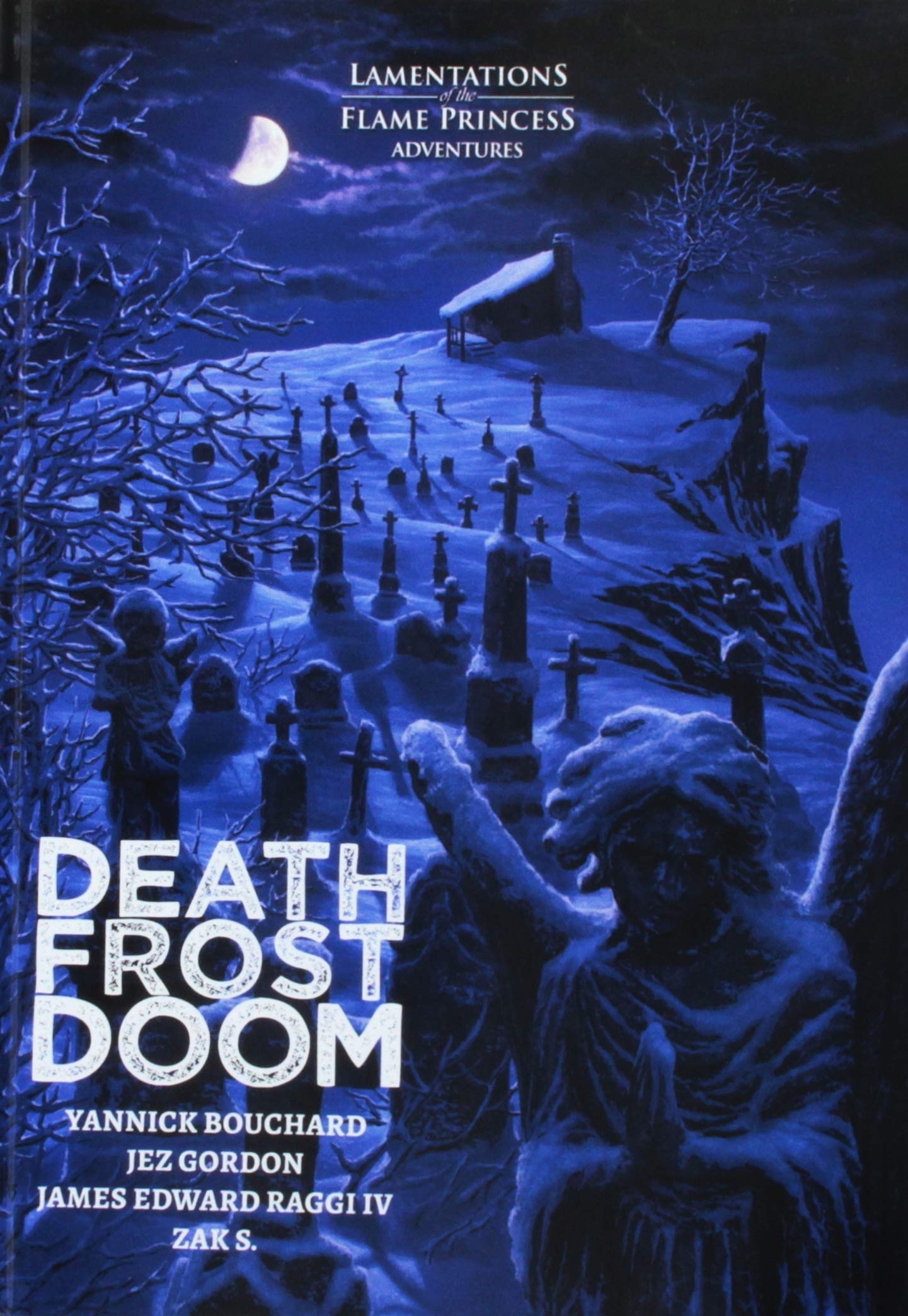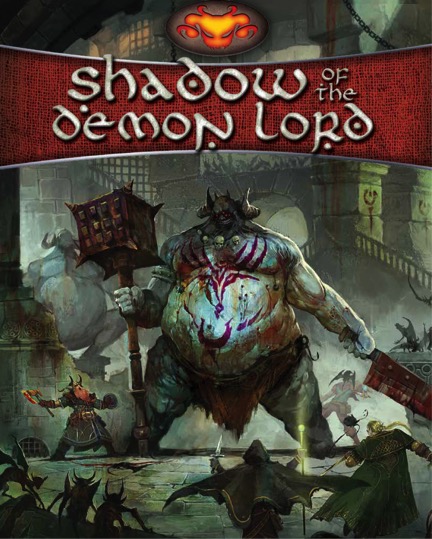There are, however, important tonal differences between the two games, as Lamentations is much more nihilistic than WFRP ever was. The Warhammer chaos gods are sometimes described as a form of 'cosmic horror', but a comparison with Lamentations shows just how humanistic they really are: they're all rooted in richly human feelings of lust and rage and disgust and ambition, whereas Lamentations mostly deals with completely impersonal cosmic forces that inflict death and suffering either by accident or just because. Chaos is all about the dark side of humanity, and confronting it is about confronting our own willingness to see other people as things to be sacrificed in the service of our own bloodlust (Khorne), pleasure (Slaanesh), survival (Nurgle), or lust for power (Tzeench). The antagonists in Lamentations, by contrast, tend to see people as just so much interchangeable meat. The chaos gods love us: Khorne loves killing us, Tzeench loves fucking with us, Slaanesh loves actually fucking us, and so on. But the beings in Lamentations just really don't care. (Do U?)

This tonal difference has some important knock-on consequences. The default Lamentations adventure pitch is 'get rich or die trying' rather than 'save the innocent from evil'. WFRP characters are plugged into the society around them by their careers: Lamentations characters are mostly assumed to be rootless wandering killers, with few if any connections to other people. WFRP scenarios tend to be human-scale, all about protecting individuals or communities, whereas Lamentations scenarios often include situations that can casually destroy the world, or at least depopulate large parts of it, in order to emphasise just how small and insignificant human lives are compared to the forces they depict. WFRP adventures are often very social affairs, all about understanding the relationships at work within settlements and organisations, whereas Lamentations adventures are usually much lonelier, set in desolated spaces where virtually everyone is already dead or worse. WFRP cultists tend to be driven by warped ambition, whereas Lamentations cultists usually just hate everyone and want us all to die, which makes their scenarios much more chilly and alienated than most WFRP adventures. Whether you view this tonal shift as an improvement or a weakness is going to come down to personal preference, but it means that several Lamentations adventures which seem on the surface as though they would be ideal WFRP fodder - No Salvation for Witches, for example, with its seventeenth-century setting and its demon-summoning coven - actually turn out, on closer examination, to be driven by very different themes.
Lamentations has been around for a decade, now, which is a long time in RPG terms, and its most WFRP-esque material was mostly released during its earlier years. Since 2016 it has increasingly focused on more experimental material, rather than on the early modern fantasy-horror that characterised its earlier output - and much as I love books like Veins of the Earth or Broodmother Skyfortress, I think you'd struggle to find a place for them in most WFRP campaigns. So what follows is a few notes on some LOTFP adventures that could be easily adapted for use as WFRP adventures, instead, insofar as they are fantasy-horror scenarios that should still work if the PCs are WFRP-style vagabonds rather than D&D-style 'adventurers'.
(I should note before I begin that I'm a year behind with LOTFP, and have yet to read any of their 2018 books, which are thus not included in this survey.)

No Dignity in Death (2009): This odd little adventure from the early days of Lamentations is a pretty minor work. It is, however, very WFRP-esque in tone, being set in an isolated little town full of self-righteous nobodies, brutal authority figures, weird customs, and dark secrets. Could be used almost as written as a refreshingly non-chaos-based interlude in an ongoing WFRP campaign.
Tower of the Stargazer (2010): This adventure is very D&D-ish in its assumption that 'the wizard's tower might have treasure in it, let's go and loot it' will be a sufficient hook to set the PCs into motion. It's a good wizard's tower, though: it could easily serve as the home of some batshit insane Celestial wizard in the depths of the Empire, and the emphasis on exploration and investigation rather than monster-hacking means that it would be much easier to translate into WFRP than most traditional D&D dungeons. Just put something the PCs need inside it and point them at the door...
The God That Crawls (2012): An anonymous commentator suggested this one in the comments thread. I felt that all the ultra-weird and world-destroying artifacts in the catacombs weren't a very good fit for WFRP, and that if you took them out then all you'd be left with was a blob in a labyrinth, but Anonymous points out that the basic set-up of a Sigmarite cult guarding a maze full of relics they'd rather keep hidden would be a perfectly viable basis for a WFRP adventure, even if none of those relics actually have the power to destroy the world. And I have to admit that getting chased around a maze by a giant slime-monster is a very WFRP-y concept for an adventure!
Death Love Doom (2012): Fair warning: the body horror in this adventure is more extreme than in any other Lamentations book, which is really saying something. It's much, much more horrible than anything that's ever appeared in a published WFRP adventure, and not at all recommended if you or your group are likely to be disturbed by scenes of appalling physical suffering inflicted upon innocent victims, including children. That said, the structure of this adventure is pure WFRP, with the house of a wealthy merchant declining into horror under the influence of a cursed artifact. Most of it could easily be adapted for use by any WFRP group with sufficiently strong stomachs.
Better Than Any Man (2013): This adventure is very WFRP-esque insofar as it's about cults and witches in the middle of the Thirty Years War, but as with Death Frost Doom the specifics are actually quite different: the anti-human omnivorousness of the insect cultists here is quite unlike that of any WFRP chaos god, and one important part of the storyline revolves around an ancient empire of evil halflings, who have no obvious WFRP equivalent. Still, a bit of work could probably turn this into an adventure about a witch re-establishing an ancient cult devoted to the worship of a bound demon prince of Nurgle who happens to be really, really fond of flies and maggots, against the backdrop of a civil war between two Imperial provinces. I'd probably remove the time travel elements if I was running it in WFRP - I'm fine with my level 1 magic-users getting bounced into the last ice age, but I prefer my artisan's apprentices to stay a bit more grounded in reality - but YMMV.
Scenic Dunnsmouth (2014): This isn't a traditional adventure: instead, it's a mechanism for using a deck of playing cards to randomly generate an awful little village in the swamps, complete with a lurking monster and an evil cult. The tone of wretched rural deprivation is very WFRP-esque, and whether you actually follow the instructions in the book or just go through picking out all the bits you like best you're pretty much guaranteed to end up with the kind of blighted, squalid little community that would fit perfectly into any backwater region of the Empire. Once again the cultists are death-worshippers rather than chaos-worshippers, but this would be an easy change to make.
Forgive Us (2014): I suspect this actually was a WFRP adventure, or at least an adventure by someone who had played an awful lot of WFRP. Thieves in an early modern city accidentally steal the wrong treasure, which ends up unleashing a magical disease that causes horrible mutations. Just add the word 'Nurgle' in a couple of places and you should be good to go.
The Idea From Space (2014): This adventure deals with an aristocrat whose ship is stranded on a remote island, where the passengers and crew swiftly fall under the sway of the feuding supernatural forces that reside there. I think this could be run in WFRP as easily as in D&D, and would resist the temptation to replace one or both of the supernatural beings on the island with chaos gods: they can just be weird things in a weird place. The New World is an under-utilised region in WFRP, and this adventure is the sort of thing that could easily fit into it.
A Single, Small Cut (2014): Theo suggested this one in the comments thread - I somehow hadn't read it before. A crazy wizard and his hired bandits murder a priest and his congregation in order to steal a demon-summoning artifact from the crypt, only to discover that they have no way of controlling the resulting beast. The PCs arrive just as the carnage starts. It's more of an encounter than an adventure, but would be very easy indeed to translate to WFRP.
England Upturn'd (2016): Stephen and Jon suggested this one in the comments thread. It's set in a seventeenth-century marshland region, complete with witch-hunters and swamp-monsters, which could very easily be used as the backdrop to a WFRP adventure. I initially left it off the list because the main story is a bit big - flipping a whole chunk of the world upside down, creating a massive tidal wave in the process, in order to unleash the evil elves of the Hollow Earth just isn't the sort of thing that happens in WFRP. But a scaled-down version, built around (say) flipping over a single hill in order to release some medium-sized threat from the underworld, could probably work pretty well.
The Cursed Chateau (2016): Stuart suggested this one in the comments thread. This adventure depicts a haunted mansion, complete with undead servants and hidden sacrificial chambers in the caves below, all of which could easily be adapted for use in WFRP. The only way out, however, is to sufficiently entertain the ghost of the sadistic aristocrat who once lived there, which seems to me to cut directly against WFRP's themes of class struggle. Add some way for the PCs to turn the tables and send the fucker straight to hell and you should be fine.





